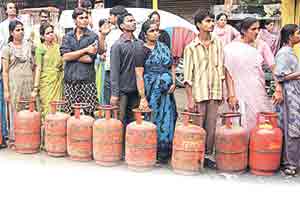Prime Minister Narendra Modi will unveil the Pradhan Mantri Ujjwala Yojana (PMUY) at Ballia in Uttar Pradesh on May 1. The scheme aims to provide LPG connections without security deposits to 50 million women from BPL households over the next three years. The scheme is expected to aggressively expand clean cooking gas and improve the health of of people by weeding out traditional chulhas currently being used by 70 crore people for cooking. Kirk R Smith, professor of global environmental health at University of California Berkeley who recently visited New Delhi, talks about the benefits of the scheme. Excerpts:
How do you think the Prime Minister’s Ujjwala Scheme would help to improve environmental health of Indian households?
This is a historic opportunity to improve the health and well-being of India’s poorest, who now bear the health and labour burden of using biomass for cooking. About 700 million people have been using biomass as cooking fuel in India for the last several decades. Without a focused programme like this to accelerate usage of clean fuels, a similar number could be caught in this ‘chulha trap’ for many years to come. Although the funds being devoted to the new programme are large, the programme is expected to be more cost-effective in producing health benefits compared to many other possible expenditure.
How big a hazard is solid-fuel-based cooking for people, particularly the women?
There are five important diseases that have been established to be caused by exposure to combustion and pollution whether as outdoor air pollution, tobacco smoke and household (cooking) smoke — pneumonia in young children and chronic lung disease, heart disease, stroke and lung cancer in adults.
All forms of smoke produce these kinds of diseases, although of course at different rates due to the different levels of exposure, with active smoking producing the highest risk per person. Each of these diseases has other risk factors as well, but use of solid fuels is thought to be responsible for a significant amount of each in India.
The key factor in implementation of PMUY is identification of BPL households and coordination between centre and state. What are your suggestions to make this scheme more effective and successful?
From the health perspective, once people have access to clean fuel, the key become finding way to encourage them to use it instead continuing also to use traditional polluting fuels. Thus, the relevant central and state agencies, including ministries of health, should develop programmes for ongoing encouragement and rewards for households to use the clean fuel, for example by linking to other national schemes, such as health insurance, rural employment, and health are for pregnant women, one of the most vulnerable groups.
In a developing country like India, what can the government do to reduce people’s dependence on biomass fuels for their day-to-day need?
The government has embarked on one of the most pioneering, innovative, and apparently successful programmes in the form of the ‘Give It Up’ campaign, through which middle-class households directly support access to LPG among BPL families. This has triggered a truly massive response with more than one crore households having participated so far and tens of thousands more signing up every day. What is needed now is a parallel campaign at similar scale for the BPL communities in the country to Give It Up as well, but in this case, finding ways to encourage them to rapidly give up their chulhas and use clean fuels for all their needs.
